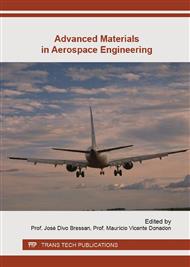[1]
Campbell, G. S.; Lahey, R. T. C. A Survey of Serious Aircraft Accidents Involving Fatigue Fracture. Volume 1. Fixed-Wing Aircraft (Etude sur des Accidents Importants d'Avions du aux Effets des Fractures de Fatigue. Volume 1. Effets sur des Avions). National Aeronautical Establishment Ottawa (Ontario), (1983).
DOI: 10.1016/0142-1123(84)90005-7
Google Scholar
[2]
Materials Today. Volume 5, Issue 11, Findlay, S. and Harrison, N. Why Aircraft Fail. Hampshire, UK. November 2002, pp.18-25.
DOI: 10.1016/s1369-7021(02)01138-0
Google Scholar
[3]
Mann, J. Y.; Milligan, I. S. (Ed. ). Aircraft Fatigue: Design, Operational and Economic Aspects. Optimum Design of joints: The stress severity factor concept. Aircraft fatigue. Jarfall, L (author), pp.49-63. Australia, (1972).
DOI: 10.1016/b978-0-08-017526-3.50010-5
Google Scholar
[4]
Potter, J M., ed. Fatigue in mechanically fastened composite and metallic joints: a symposium. No. 927. Pages 221 – 250, Heimo Huth. ASTM International, (1986).
DOI: 10.1520/stp927-eb
Google Scholar
[5]
Morris, G. Defining a standard formula and test-method for fastener flexibility in lap-joints. Ph-D. Thesis, TU Delft, Delft (2004).
Google Scholar
[6]
Müller, R. P. G., An experimental and analytical investigation on the fatigue behavior of fuselage riveted lap joints. TU Delft, Delft University of Technology, (1995).
Google Scholar
[7]
De Rijck, J. J. M. Stress analysis of fatigue cracks in mechanically fastened joints: an analytical and experimental investigation. TU Delft, Delft University of Technology, (2005).
Google Scholar
[8]
Skorupa, M.; Korbel, A. Modelling the secondary bending in riveted joints with eccentricities. The Archive of Mechanical Engineering. Vol LV, Number 4. (2008).
Google Scholar
[9]
Gonçalves, Roberto da Silva. Previsão de vida em fadiga de juntas para aplicações aeronáuticas, baseada no fator de severidade de tensão. 2015. 102f. Dissertação de Mestrado em Mecânica dos Sólidos e Estruturas – Instituto Tecnológico de Aeronáutica, São José dos Campos, Brazil.
DOI: 10.47749/t/unicamp.2013.913536
Google Scholar
[10]
Liu, A.; Mechanics and mechanisms of fracture: An introduction. ASM International. USA, (2005).
Google Scholar
[11]
Pilkey, W. Peterson's Stress Concentration Factors. Second Edition. John Wiley & Sons, Inc. New York, USA. (1997).
Google Scholar
[12]
Dowling, N., Mean Stress Effects in Stress-Life and Strain-Life Fatigue, SAE Technical Paper 2004-01-2227, 2004, doi: 10. 4271/2004-01-2227.
DOI: 10.4271/2004-01-2227
Google Scholar
[13]
MMPDS. DOT/FAA/AR-MMPDS-1, Metallic Materials Properties Development and Standardization, January, (2003).
Google Scholar
[14]
THE GUARDIAN. http: /www. theguardian. com/business/2012/nov/08/a380-cracks-repair-200m-euros, Accessed on July 11th, (2015).
Google Scholar


